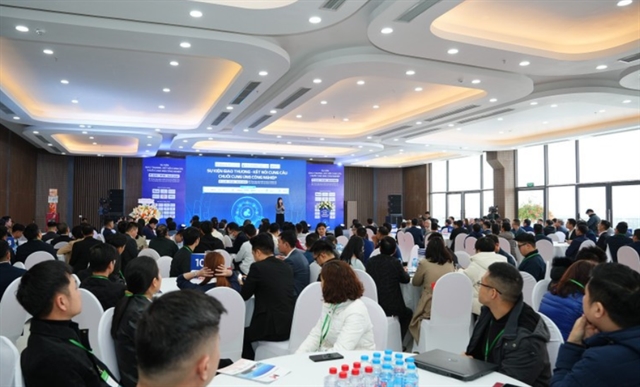 Economy
Economy

 |
| Dr Nguyễn Bích Lâm, former general director of the General Statistics Office. — VNA/VNS Photo Thúy Hiền |
The General Statistics Office (GSO) has recently released its “Report of Việt Nam’s Labour Productivity in the 2011-2020 period: the current situation and solutions". The report shows that although improving, Việt Nam's labour productivity level is still very low compared to other regional countries and that the absolute disparity continues to widen.
To better understand the situation and solutions to increase labour productivity, Vietnam News Agency spoke with the former general director of GSO, Dr Nguyễn Bích Lâm.
The GSO report shows that Việt Nam's labour productivity has not reached the level of other regional countries. What is the cause of this situation?
The labour productivity in Việt Nam is currently still far lower than that of other countries in the region due to the small size of the economy, with a low starting point, and the slow transition from labour-intensive industries with low labour productivity to industries that create a lot of added value and have higher labour productivity.
Labour in agriculture and informal sectors still account for a high proportion, with low professional and technical qualifications. Machinery, equipment and technology used in production are out of date, and the vast majority of Việt Nam's enterprises are small and medium-sized with inefficient management and use of resources.
Finally, bottlenecks and barriers in institutional and administrative reforms hamper labour productivity.
How has the slow improvement of labour productivity impacted the Vietnamese economy?
Labour productivity is slowly improving, increasing the absolute divergence between the Vietnamese productivity level and that of other regional countries. It also causes our economy's competitiveness to decline, so Vietnamese products struggle.
In addition, outdated technology and low productivity make it more difficult for Việt Nam to participate in global and regional supply chains. It also hurts the country’s ability to attract FDI projects that require highly qualified and skilled workers, and increases the possibility of Việt Nam's economy falling behind and falling into the middle-income trap.
In recent years, the process of economic restructuring has significantly contributed to increased labour productivity in Việt Nam. Can this continue to be the driving force for productivity growth in the future?
Labour productivity improvement of the economy is created through economic restructuring and labour restructuring, by improving labour productivity within economic sectors (internal labour productivity), and by simultaneously carrying out the process of economic restructuring and improving intra-industry labour productivity.
Therefore, economic restructuring is only one of the factors driving the increase in labour productivity. Still, this motivation is not as important as the improvement in intra-industry labour productivity, and there is not much room left for the motivation to take effect.
What are the factors affecting labour productivity in Vietnamese enterprises?
For enterprises, there are five groups of factors affecting labour productivity: qualifications and skills of employees and corporate governance capacity; property, equipment and technology used in production; participation in global markets and innovation; the size of the enterprise; and the extent of urbanisation and the geographical location where businesses set up factories.
These factors have not met the requirements of improving labour productivity, and the Vietnamese labour market has still exposed some shortcomings.
Labour structure in three economic sectors is not ideal, with workers in agriculture, forestry and fishery industries accounting for 27.5 per cent of the total. In the informal sector, the number of labourers increased rapidly, but their jobs and income are highly vulnerable to the market's volatility. Seasonal workers usually have limited skills as they are often not trained sufficiently.
The percentage of trained workers with qualifications and certificates is still low. Unqualified labour accounts for 72.5 per cent of the total employees. Among the rest, those with elementary qualifications account for 6.8 per cent; those with intermediate certificates, 4.3 per cent; those going through colleges, 3.7 per cent; and those having university or higher qualifications, 12.5 per cent.
According to the Japan International Cooperation Agency, the low level of education and technical expertise of Vietnamese workers makes Việt Nam one of the lowest productive countries in the region.
Currently, enterprises in the manufacturing and processing industry – an industry that reflects the level of technology used in production – are still mainly engaged in labour-intensive assembly activities.
Experience shows that innovation is an unlimited driving force for growth and labour productivity improvement, but our country's technology and innovation are still low-ranking fields. The Global Competitiveness Report during the Fourth Industrial Revolution (GCI 4.0) in 2019 showed that Việt Nam ranks 67th out of 141 economies in terms of the GCI 4.0 index but only ranks 93rd in skills, the lowest ranking of the 13 indicators.
In your opinion, what are the solutions for Việt Nam to speed up the improvement in labour productivity more effectively?
The Government needs to develop and successfully implement the National Strategy on Labour Productivity with specific objectives and an implementation roadmap for each period to catch up with other countries.
Along with that, the Government should promulgate and implement breakthrough solutions and businesses-centric policies to create conditions and pressures for them to access, apply and innovate technology along with improving innovation capacity. At the same time, it is necessary to remove barriers and bottlenecks in institutional reform related to the labour sector.
It is also important to maintain macro stability, accelerate economic restructuring in association with growth model innovation, speed up digital applications, and restructure the agricultural sector along with new-style rural area construction.
In addition, it is necessary to develop a market of science and technology applied to production. Ministries and agencies should have training policies to improve the quality of human resources with high professional and technical qualifications, meeting the requirements of integration and participation in global value chains.
For the business sector itself, it is necessary to improve technological and innovative capacity; innovate production processes and organisational structures; and promote joint ventures with FDI counterparts to learn and acquire new technology and governance and management skills.
We have relatively abundant resolutions from the Party and strategies from the Government directing labour productivity improvement. But these policies are still slowly put into practice. It needs to have a committee in charge of guiding and coordinating stakeholders in realising these solutions. — VNS




